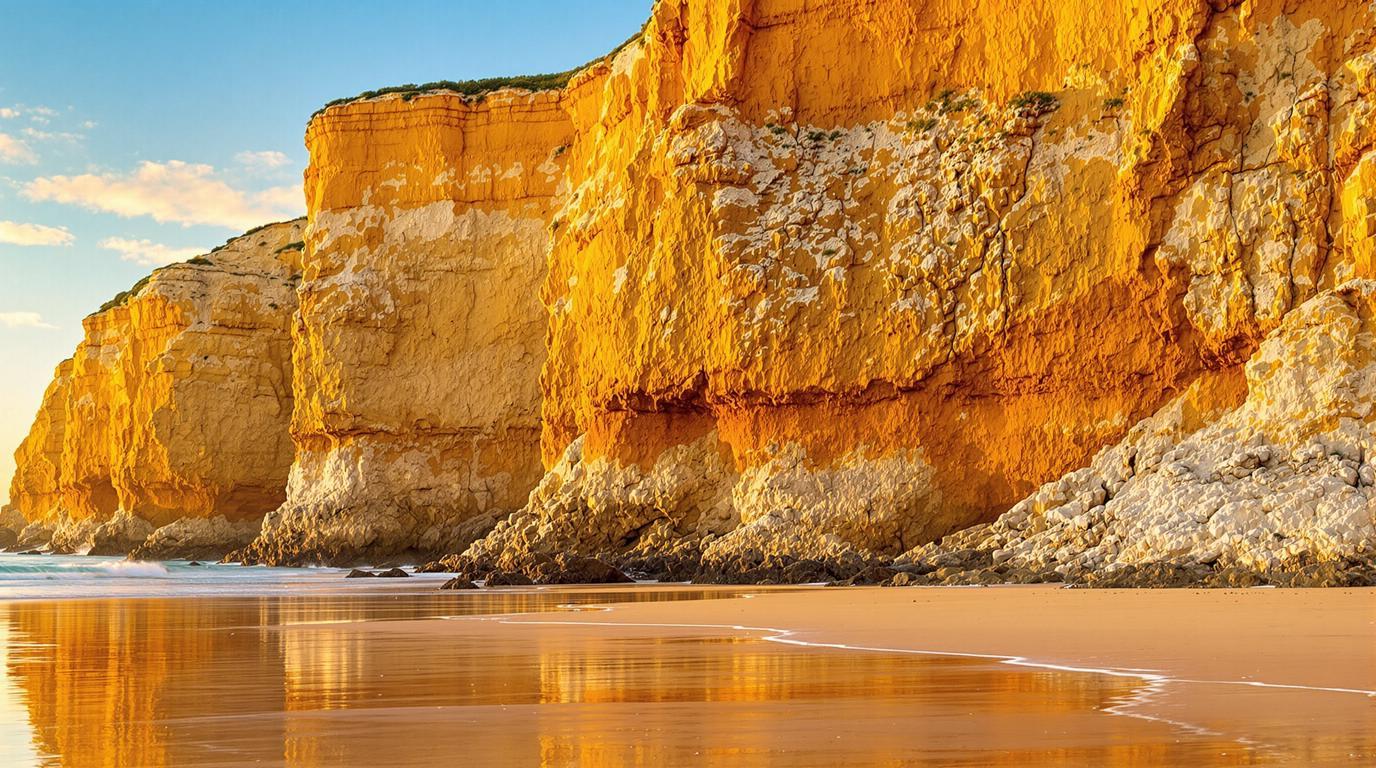Standing at the edge of Bretagne’s Côte Sauvage, I watched the morning light transform ordinary golden cliffs into pillars of liquid amber. This wasn’t the Brittany of postcards—no gray granite coastlines or medieval harbors. Instead, the spectacle before me was France’s geological rebel: Plage de la Mine d’Or, where the remnants of a century-old gold mining operation have created one of Europe’s most distinctive and overlooked coastal landscapes.
Where fortune hunters left a golden legacy
Tucked into Brittany’s southern coastline near the village of Pénestin, this two-kilometer stretch of fine sand sits beneath ochre cliffs that seem to glow from within. These 12-meter high natural walls earned their name from the gold mine that operated here until World War I, though their color comes from iron oxide rather than precious metals.
“People come expecting to find gold nuggets,” laughs Marie Kerouac, whose family has lived in Pénestin for generations. “But the real treasure is the light on these cliffs at sunset—it’s the kind of natural performance you can’t find elsewhere in Brittany.”
Unlike the region’s typical tourist havens, Mine d’Or remains surprisingly uncrowded, even as it offers one of the most dramatic coastal scenes in western France, just hours from a remarkable French island with 34 palm tree species.
Uncovering coastal secrets beyond the golden wall
The douanier’s path to hidden coves
Following the narrow Sentier des Douaniers (Customs Officers’ Path) that winds along the clifftop, I discovered what most visitors miss. Just beyond the main beach, the path dips toward a series of intimate coves accessible only at low tide. Here, shallow tidal pools form natural aquariums where starfish and translucent shrimp become temporary residents until the Atlantic reclaims them.
Soaring perspectives above mineral canvas
For the truly adventurous, local paragliding outfitters offer tandem flights from the cliffs’ highest points. My morning flight revealed the mesmerizing patchwork of ochre, sienna and amber mineral deposits veining through the cliffs—natural artwork invisible from below. The thermal currents rising from the sun-warmed cliffs create ideal conditions for extended flights, making this spot a favorite among European gliding enthusiasts.
Tasting Brittany’s coastal bounty in unexpected places
Skip the waterfront tourist establishments and head two kilometers inland to Le Petit Moulin, where Breton cuisine gets a contemporary interpretation. Their buckwheat galettes filled with just-caught mackerel and sea-foraged samphire offer a perfect harmony of land and sea.
What makes these galettes special is chef Pierre Lemont’s technique of folding seaweed butter into the batter—a trick his grandmother taught him. “The sea gives us everything we need,” he insists. “Our job is simply not to ruin it.”
For those exploring broader regional flavors, consider a day trip to the charming village with Europe’s shortest river, where water-powered mills once produced some of Brittany’s finest flour.
Making the most of Mine d’Or’s golden moments
Timing your visit for solitary splendor
The beach transforms throughout the day, but arrives between 7-9am or an hour before sunset for the most dramatic lighting on the cliffs. Weekday visits in May, June or September offer ideal conditions: warm enough for swimming but free from summer crowds.
Accommodation secrets for cliff views
Book the eastern-facing rooms at La Maison du Douanier, a converted customs house perched directly above the northern end of the beach. Their terrace rooms offer private cliff-top access that’s particularly magical during full moons when the golden walls seem to phosphoresce in the silvery light.
For adventurers seeking coastal experiences beyond Brittany, consider this remarkable Corsican mountain village near Mediterranean beaches, which offers a completely different seaside aesthetic.
Carrying the golden light home
As I left Mine d’Or, I realized what makes certain places linger in memory isn’t their fame but their distinctive character. In a region celebrated for its rugged gray coastlines, this golden interlude remains a geological anomaly and a traveler’s revelation—proof that sometimes the most affecting destinations are those that break the pattern of their surroundings.
